Contents
Content localization: everything you need to know
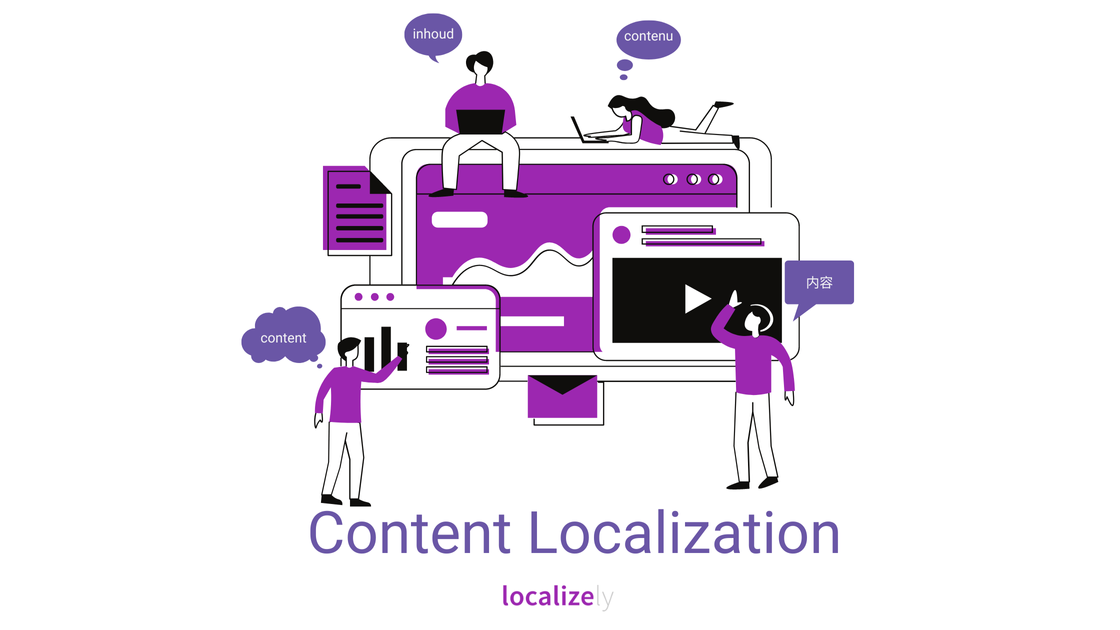
Content marketing became a thing just recently. About 60-70 years ago, marketing was mostly about advertising. There were some different practices - like Michelines’s guide for restaurants - but those were exceptions.
Right now, we live in a rising shredding practice of marketing. We have more marketing departments than discussions of how ethical certain practices are.
We have marketing departments named by the channels (social media marketing, youtube marketing, digital marketing, email marketing…), objectives (demand generation, lead, generation, PPC, …), or products (content marketing, event marketing….), focus (outbound, inbound, direct response…).
However, all of this is content marketing.
As Lazar Džamić and Justin Kirby argue in their book The Definitive Guide to Strategic Content Marketing - there is no marketing without content. If you don’t have content, what are you even pushing on every channel?
All these labelings tend to get more complicated once we enter the localization process. There are so many questions. Who will be responsible for the localization of the content? What needs to be localized, and in which order?
What is content localization?
Content localization is the creation of content specialized for a specific geolocation in a local language.
Creation can include the curation of completely new content and tailor-made campaigns for the specific market, or it can be focused on translation and adaptation from the existing source content and campaigns.
How you’ll do it depends on your possibilities and budget. The most important thing is to know what you’re doing and why you’re doing it.
Why you need to localize your content
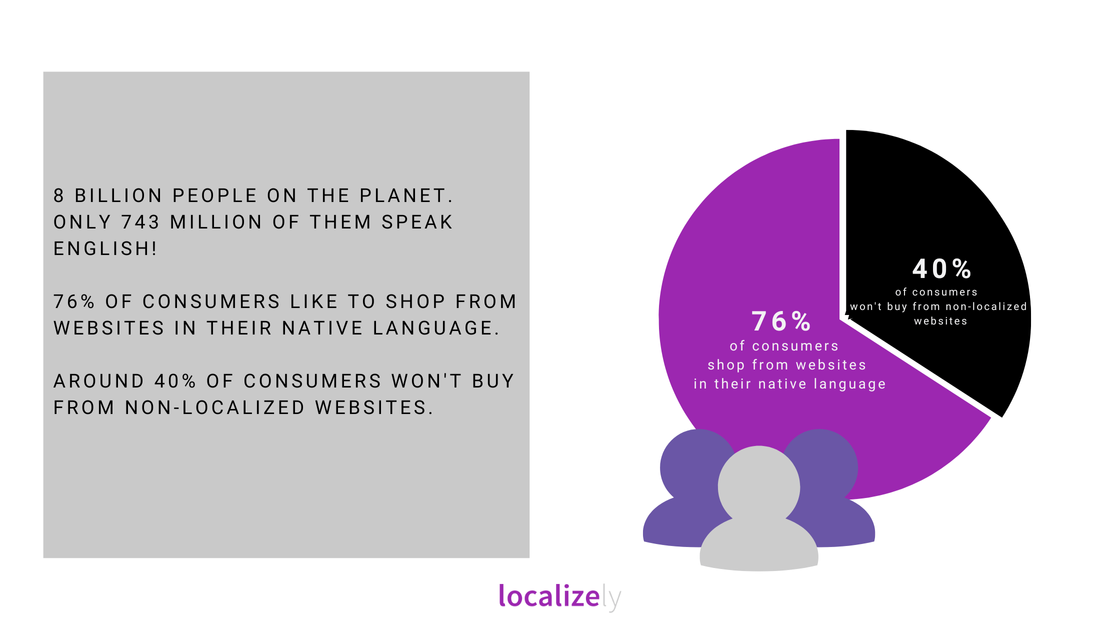
There are multiple arguments for this approach, but the most important ones are higher possibilities for market penetration and better conversion on the local market.
Content marketing generates more than three times more leads than outbound marketing and costs 62% less if your audience understands what you’re talking about. This brings us to the fact that having content in English is not always the best solution for going global and conquering the international market.
One of the reasons this happens is the discrepancy between what we perceive as the number of English speakers - like those assumptions ”everyone speaks English these days” - and the actual numbers.
Right now, there are more than 8 billion people on the planet. Only 743 million of them speak English.
Additionally, 76% of consumers prefer to shop from websites with content in their native language. Moreover, around 40% of consumers are unwilling to buy anything on non-localized websites.
How to create a content localization strategy
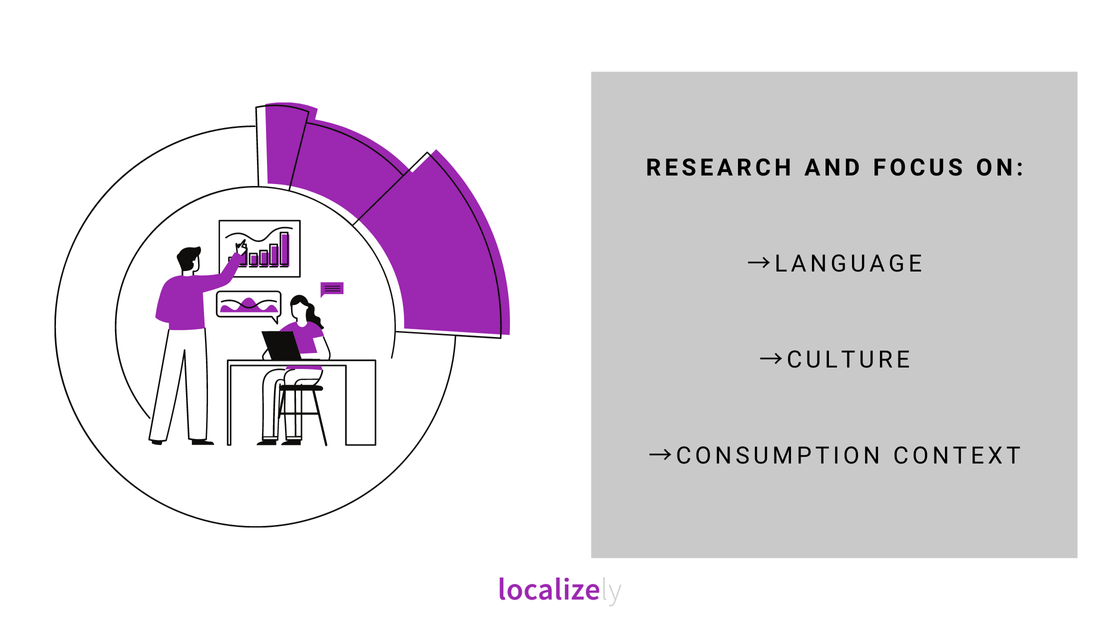 Localization efforts go in vain if the strategy is sloppy. Entering the foreign market needs to be very well planned; before that, all options need to be researched in detail.
Localization efforts go in vain if the strategy is sloppy. Entering the foreign market needs to be very well planned; before that, all options need to be researched in detail.
You may think that the proper translation of the content is enough, but the truth is that you need to take care of geolocation and cultural differences more than you need to take care of language solely.
Let's start with English, that's often considered a global language of the XX and XXI centuries. The language itself has different dialects, vocabulary, and spelling rules based on geolocation where the language is used. So you have different wording for the same thing in British English, American English, and Australian English.
That same thing happens with Spanish in Spain, Mexico, Peru, Columbia, and Argentina, or think of French in France, in comparison to the French in Switzerland and Canada...
The list goes on and on with every language you pick. Also, in the cultural context of consumption and decision-making differentiates based on geolocation, not exclusively on language.
This means you'll need to consider various factors while researching, analyzing, decision-making, planning, hiring, and deploying.
Research and analysis
The first step to strategy creation is setting fond with information you get from research and data analysis.
We recommend hiring a localization specialist specializing in geolocation, the industry, and the language you're trying to enter, as it can save you tons of money for the trial and error process.
Whether you’ll going to do it in-house or outsource it - choose the geolocation where you want to enter the new market and research thoughtfully following fields:
-
Language: dialects, habits, and vocabulary that you need to use so the local audience gets fond of you.
-
Culture: type of humor, possible cultural differences, and conflicts that can influence how you approach the local audience.
-
Consumption context: how people usually make decisions in your industry, what kind of information they are lacking, cash flow, card, mobile banks. Anything that'll influence website localization and content localization in any form.
Decision making
Once you have done the detailed analysis and you have everything in one place, you need to make some decisions about your marketing materials. Are you going to translate the existing ones or create new ones from scratch, so they're fully adapted to the new market?
If you're translating: what goes into translation sequences, and in which order? Is there anything that should be left out of the existing content and eventually created from scratch because, in this form, it wouldn't resonate with the local audience?
If you're (re)creating: what type of content goes first, what campaigns are you focusing on, how do you adapt visual identity and tone of voice in a new culture context…
Go through this kind of content audit for all channels: blog, social media, youtube, and newsletter. After the analysis, prioritize translation and creation of the digital content across all platforms.
Planning
Last but not least, we came to the planning sessions.
Content marketing localization is similar to software localization - it's dynamic, with multiple iterations and factors that influence the process. That's why your content localization strategy needs to include such a detailed research analysis and decision-making. If you do that right, planning will be easier and project management more realistic.
Localization workflow mostly includes these five steps (if you use translation management tools):
-
Uploading the main language file
-
Translating
-
Reviewing
-
Downloading all language files
-
Publishing to end-users
If you’re using Excel tables or Google Sheets for translation management, the process will include additional steps for developers and project managers. They’ll need to cut the content into strings and import string by string into the tables. After the translation process, they’ll need to put strings back into the files and push information back into the app - which means more coding.
Either way, the process usually starts and ends with developers, but quality translation services and an exceptional localization project manager are what you need to thrive in this process.
Choosing the best translation management system for your needs will significantly affect the process's length and cost. Translation management software contains features like in-context editors, machine translation, translation memory, glossary, and much more. All these options can speed up and facilitate the process.
The usual practice in the localization industry is to have developers, localization specialists, and localization managers in-house and to outsource the rest. This brings us back to translation management tools - the good ones have an option where you can hire translation services specialized in your industry directly on the platform, so you don't have to waste time searching for that personnel.
Testing is an integral part of the localization workflow, and it can be quite tricky if you've missed previous steps, as you won’t have reference points to check with.
However, in any content creation practice during the deployment, focus on publishing a small volume and gathering feedback first. Once you're sure you got an understanding of the new market, go fully with localized content.
Different types of content and how to localize them properly
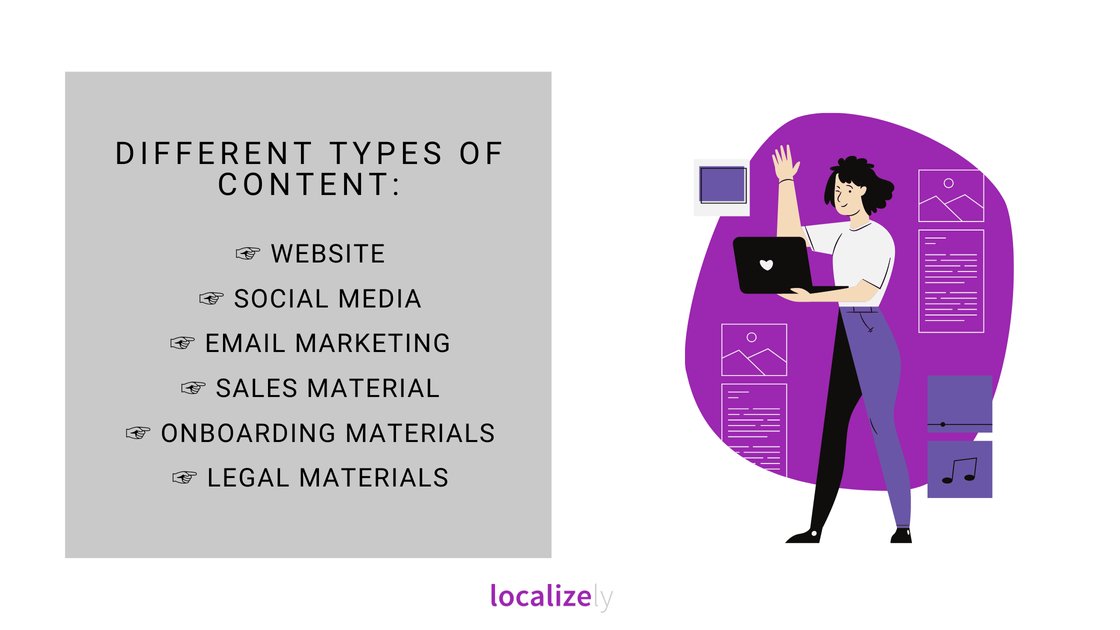
As we mentioned in the introduction, marketing content is everything that marketing campaigns are made of. Content can be of different forms, with distinct focuses, and presented on various platforms, but the truth is - all of that is still content.
So when you do content localization, you should also keep in mind the rules specified for every form and channel.
Website
When localizing website content, focus on user experience, conversion, and search engine optimization for a particular region. A website is like an ID for your brand, so ensure you have at least one localization expert for effective content localization.
During the planning of the website translation, pay attention to the following pages and details:
-
Home page: landing pages, about us: here, pay attention to the design and copy, as you would in source language - what colors and wording work best for the local market, and how to create the best UX, especially for them.
-
Contact forms, Sign up, and Sign in: be careful when creating options for time and date formatting; for example, North America has date formats MM/DD/YYYY, while Europe uses DD/MM/YYYY. Also, names can be formatted differently and require different amounts of space - for example, in Central and South America, people tend to have at least two names and two surnames. Additionally, consider all cultural differences around payment options when localizing sign-up forms.
-
Pricing pages: make sure to localize currencies and adapt numbers when needed, as prices on some international markets are not affordable in every region. Additionally, pay attention to measurements, colors, and other vocabulary that may influence understanding and decision-making.
-
Blog: translate the articles that would resonate with a local audience, like those that are talking about products or services or give information that is unique everywhere, adapt use cases, and for case studies, translate only those that mention the globally known brands, and create from scratch new ones with regional brands.
Social media
Whatever you do, whatever social media platform you use, please don't use multiple languages from the countries you're present in one single post or account.
Open a separate account for every country you're doing business with, and use the local language. While keeping your brand's tone of voice and colors, adapt the design and copy to the local market.
A good example can be how Lidl, a German retail chain, does its social media across Europe. They have a separate account for every country that's adapted to the way the locals consume content - you can notice that there's a direct shop only on some accounts, that profile description is different on every account, but that the content is similar - as well as the faces they found for their ambassadors, even tho they're locals.

If you don't have enough resources, then run an account per platform only in one language that most of your customers will understand, no matter the region or country.
The additional good thing is that platforms like Instagram and Facebook have their machine translation options, and Google Translate is on Google Chrome, so on those two channels, you can have AI help for the start.
Email marketing
If you're unsure whether you should localize email marketing - the answer is very simple, and it's yes. As well as other channels, email is for both conversion and nurturing, and you won't have that option for every region in which your business is present.
You can use the same campaigns for all markets. However, you'll need to translate the text and adapt the design and nurturing phase and options according to the cultural context - from ambassadors and local magazines and events, you may refer to options you use as awards. For example, coupons are a huge thing in the USA, but they're not so developed in most of the other countries around the world.
Sales materials
Sales enablement content is essential in the B2B industry. PDFs, Ebooks, Pitch desks, presentations - you name it, and you need it translated as well.
When we talk about the localization of sales content, it's necessary to highlight the importance of relevant references. Basically the same as when we talked about case studies - you need to focus on cases and successful brand campaigns that'll resonate with the local market.
Remember to adapt prices and currencies and to consider cultural context when crafting sales enablement materials.
Onboarding materials
Regarding nurturing your clients, we all know that good onboarding is crucial for high retention and low churn.
That's why you should definitely localize content that is part of onboarding sequences. No matter if we talk about pop-ups, support documentation, or training videos.
The written content should be translated for sure, while for video content, you can use the original video and just add subtitles in the local language for every market you're operating in.
As for live training - you'll need a local expert or a localization specialist who can translate simultaneously, as live events are not easily localized content.
Legal materials
We hope you didn't mean to launch in a new market without localizing legal content.
Even though you have crafted all legal documents for your primary legal entity and a primarily local market - more is needed than a translation of the documents. Legal rules differentiate from country to country. That’s why you’ll need to make this content localized by consulting with legal experts in the country you want to enter.
Additional things to consider
Hyperlinks - When translating the content, don’t forget to change outbound hyperlinks. Swap the original ones with the link in the target audience's native language whenever possible.
Images, Emojis, Colors - One of the specifics of multilingual design is to take care of all visual aspects as well. Maybe some images you currently have aren’t sending the same message in a new market. Maybe the culture you’re entering uses emojis in a different context. We hope you did your research from the beginning thoroughly.
Formatting - If you’re localizing content for Middle and far East markets, you need to take special care of formatting - right to the left of up to the down writing and reading is more familiar for those cultures!
How to measure content localization
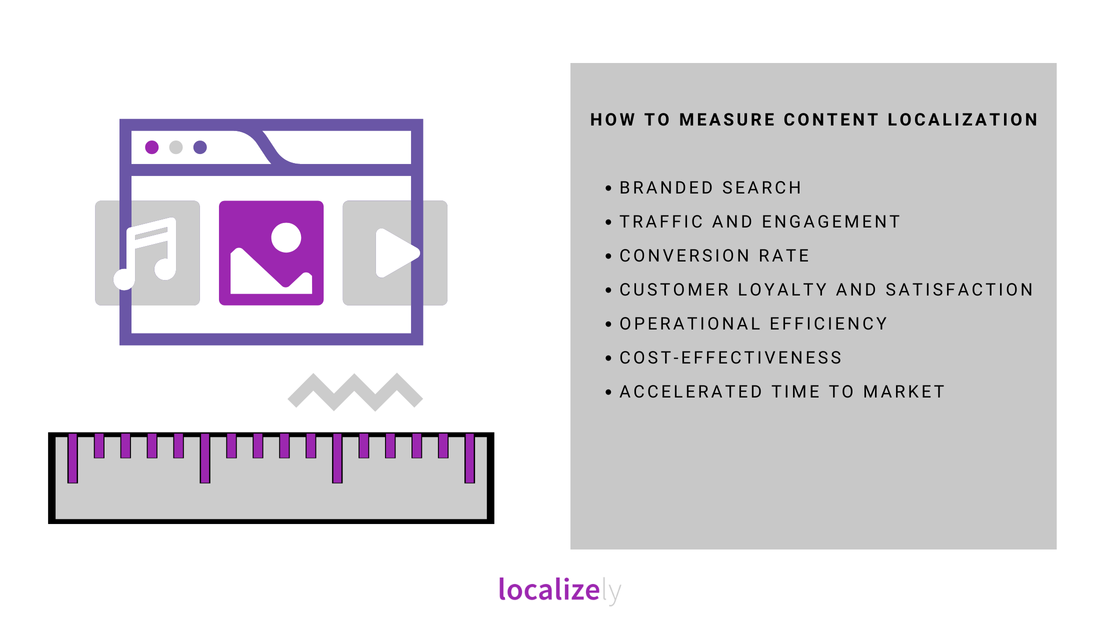
Once the work is done, there is an urge to measure the success and the results. Some channels may be measured through attribution, but most can’t. Especially if you’re new to the market and you're doing demand generation more than direct paid advertising.
So what should you pay attention to then?
-
Branded search
If you see improvement in the keywords that are branded or related to your brand, it’s soundproof that your content marketing efforts are giving results.
The brand is gaining visibility, authority, and credibility.
It’s also a signal that you’re delivering content that gives you a competitive edge, as your brand is becoming a synonym for the industry.
-
Traffic, search engine rankings and engagement
We all know by now that number-one ranking is a relative thing with all those feature snippets, ads, and individualized searches, but yes rankings are still a thing.
But what should interest you from the ranking is the amount of traffic, its quality, and the type of engagement you get from that traffic.
It’s easy to get lost in the abyss of vast metrics, so make sure you’re not chasing numbers that are not meaningful to your revenue.
-
Conversion rate
If your content resonates with your target audience, your conversion rate should go up in the long run.
This doesn’t mean you’ll be able to attribute each additional conversion to the particular piece of content. You’ll just notice an “unexplainable” rise in conversions that actually comes from generated demand and improved brand positioning through content marketing.
-
Customer loyalty, satisfaction, and a number of support tickets
Okay, yes this has to do a lot with the quality of the product and how the customer support department does its job, but think about it from the other point of view.
If your content is so good that your customers are inspired and guided through every level, every imaginable process - they will love you, they will stay with you, and they’ll spread the word about you.
-
Operational efficiency and cost-effectiveness
Speaking of SEO cost only - it’s easier and less costly to position on the local market with content in the local language than with content in English, as Google has geolocated bots crawling websites separated and in addition to USA-located bots. So there's a much smaller pool to fill in a localized context than in a global one, which means less money to invest.
Additionally, using translation management tools can help you speed up the localization process - cutting hours for developers, translators, and designers.
-
Accelerated time to market
Every conquered market will help you to conquer the next one. It’s like a compound effect.
Investing in content is investing in the brand’s future
This may sound cheesy, but let's face the truth - there’s no marketing with content. And what’s marketing but a brand’s positioning in the market?
It may seem like a ton of work - because, honestly, it is - but when done right it’s worth it.
Research thoroughly, plan effectively, adapt channel by channel and enjoy the fruits of your labor in your revenue growth.
Like this article? Share it!
Bojana is a Content Marketing Consultant at Localizely. She is interested in languages and marketing. Also, she is a big fan of tech products.
Enjoying the read?
Subscribe to the Localizely blog newsletter for quality product content in your inbox.
Related
Resources
- What is Localizely?
- Getting started
- Localization workflow
- Translation editor
- Flutter Over-the-Air updates
- Flutter In-Context Editing
- Project branching
- Professional translation services
- Machine translation
- Translation Memory
- Glossary
- Reports and statistics
- Figma integration
- AWS S3 integration
- GitHub integration
- GitLab integration
- Bitbucket integration
- CLI
- Configuration file
- Supported file formats
- Language & Country Codes
- Referral Program
- I18N Questions
- FAQ